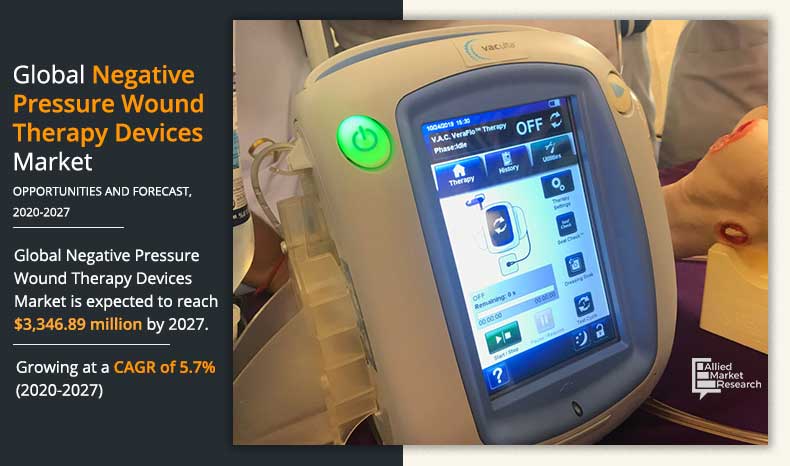
NPWT Devices Market Size 2023 – 2027 | Growth, Analysis, Demand and Forecast with the CAGR of 5.7%
The global negative pressure wound therapy devices industry was estimated at $2.14 billion in 2020, and is expected to hit $3.34 billion by 2027, registering a CAGR of 5.7% from 2020 to 2027.
Portable and Disposable Systems: The market offers both portable and disposable NPWT devices, providing flexibility and convenience to patients and healthcare providers. Portable devices allow for increased mobility and can be used in home care settings, while disposable systems reduce the risk of infection and simplify the dressing change process.
Advanced Technologies: Manufacturers are continuously introducing advanced technologies in NPWT devices to enhance their efficacy and patient comfort. These advancements include the development of intelligent wound dressings, integrated systems with remote monitoring capabilities, and the incorporation of smart sensors for real-time feedback.
Increasing Adoption in Hospitals and Clinics: Hospitals and clinics are the major end-users of NPWT devices. The devices are used in various healthcare settings, including acute care, long-term care, and outpatient facilities. The growing adoption of NPWT devices in these settings is driven by their effectiveness in wound management and the potential to reduce hospital stays and healthcare costs.
Request Sample Report at: https://www.alliedmarketresearch.com/request-sample/434

Market Segmentation:
Product Type:
Conventional NPWT Devices: These devices consist of a vacuum pump, a collection canister, and a wound dressing. They are widely used and have been in the market for a longer time.
Single-use NPWT Devices: Also known as disposable NPWT devices, these are designed for one-time use. They eliminate the need for canister emptying and reduce the risk of infection. They offer convenience and ease of use.
Application:
Chronic Wounds: This segment includes diabetic ulcers, venous leg ulcers, pressure ulcers, and other types of chronic wounds that require prolonged wound care.
Surgical Wounds: NPWT devices are commonly used to manage post-operative wounds, including incisions from various surgical procedures.
Traumatic Wounds: This segment includes wounds resulting from accidents, injuries, or trauma that require wound healing assistance.
End User:
Hospitals: This segment includes various types of hospitals, including tertiary care hospitals, secondary care hospitals, and specialty hospitals, where NPWT devices are commonly used for wound management.
Clinics: This segment comprises outpatient clinics, wound care centers, and specialized clinics that provide wound care services and utilize NPWT devices.
Homecare Settings: With advancements in portable NPWT devices, these devices are increasingly being used in homecare settings, allowing patients to receive wound care in the comfort of their homes.
Geography:
North America: This region includes the United States and Canada, which have well-established healthcare infrastructure and a high prevalence of chronic wounds.
Europe: This region comprises countries such as Germany, France, the United Kingdom, and others, where the NPWT devices market is driven by increasing healthcare expenditure and a growing aging population.
Asia Pacific: This region includes countries like China, Japan, India, and others, where the market is driven by a large patient population, rising healthcare awareness, and improving healthcare infrastructure.
Latin America: This region comprises countries such as Brazil, Mexico, and others, where the market growth is influenced by improving healthcare access and increasing chronic wound cases.
Middle East and Africa: This region includes countries such as Saudi Arabia, South Africa, and others, where the market is driven by a growing focus on advanced wound care solutions.
Request for Customization –
https://www.alliedmarketresearch.com/request-for-customization/434
Regional Growth Dynamics:
Based on region, North America garnered the major share in 2019, holding around two-fifths of the global negative pressure wound therapy devices market. This is due to the presence of key players in the region, easy availability of NPWT devices, surge in prevalence of medical conditions leading to acute and chronic wounds, and rise in launch of new and advanced products. Simultaneously, the Asia-Pacific region would portray the fastest CAGR of 7.9% till 2027. This is attributed to factors such as surge in adoption of NPWT devices and rise in healthcare expenditure.
Competitive Landscape:
ATMOS MedizinTechnik GmbH & Co. KG
Talley group Ltd.
Cardinal Health.
Smith & Nephew Plc.
DeRoyal Industries, Inc.
Devon International Group,
3M (Acelity L.P. Inc.,)
Investor AB (Mölnlycke Health Care AB)
ConvaTec Group Plc.
Procure Complete Report at 15% Discount:
https://www.alliedmarketresearch.com/purchase-enquiry/434
Key Points Covered by the Report-
- What are the fundamental skills, core competencies, and key players in the industry we are examining?
- What are the opportunities for marketing strategies that are developing at a usual rate?
- What are the main competitive factors influencing the industry?
- What marketing tactics are suitable for a particular service or product?
- What geographical areas are covered by the NPWT Devices Market report?
- What share of this market would each of the following regions hold during the forecast period: Asia-Pacific, Europe, North America, and LAMEA?
- How has COVID-19 impacted the NPWT Devices Market?
Related Reports :
Editor Details
-
Company:
- The Wire Times
